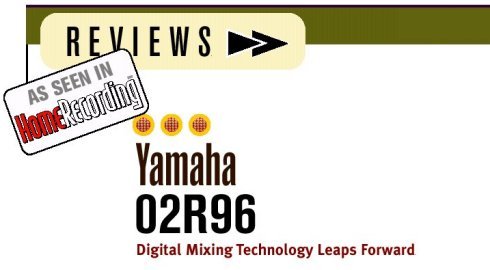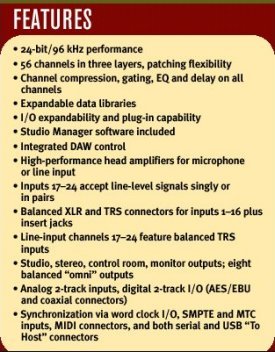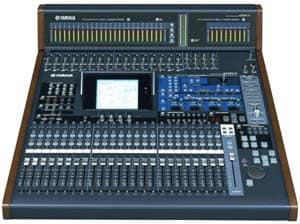02R96 Digital Mixing Console (Home Recording Magazine, April 2003)
 By David Darlington |
 |
HEN IT COMES TO DESKTOP DIGITAL mixing consoles, Yamaha has always been one step ahead of the pack. It was first to test the techno-logical waters with the DMP-7, and in 1995, with the introduction of the original 02R, the company blew everyone away by packing an incredible amount of features into a physically small but sonically tremendous package. Yamaha's crown has been challenged lately by a number of other entries into the field, notably the Tascam MX-24 and the well-known Mackie D8B. But Yamaha has come thundering back, answering with the feature-packed, high-resolution 02R96. With more than five times the processing power of the original, the new 02R has been brought up to today's 24-bit/ 96 kHz industry standards, and, combined with elements from its flagship DM2000 console, like surround mixing, PC interfacing, and DAW control, it surpasses anything in its price range.
 |
Right out of the box, you can tell that Yamaha packed as many features and upgrades as possible into the same footprint as the original 02R. In fact, I found most of the rear-panel connections in the same place, making it easy to replace my 02R with the 02R96. The attractive metallic blue-and- gray faceplate also maintained a sim-ilar layout, so it was easy to navigate, but given the amount of dedicated buttons and encoders (knobs), there was obviously plen-ty of new stuff under the hood. As the name implies, the 02R96 supports high sampling rates of 96 and 88.2 kHz, but is equally at home with the standard 44.1 and 48 kHz formats, at 24-bit resolution. All internal processing is done at 32 bits, which provides very precise, detailed resolution.
GETTING CONNECTED
The 02R96 features 24 touch-sensitive faders in four “layers,” controlling a whopping 56 inputs and 20 busses. (Like all digital consoles, each part of the hardware has multiple functions.) A/D conversion begins with 16 mic preamps, 24 line inputs, and 16 insert points, while D/A feeds the main stereo output and eight “omni” analog outputs. Jacks are also provided for three digital 2-track recorders and two analog 2- tracks, and the stereo tracks can also be routed for use as input signals for connecting digital effects units. Control room and studio monitors are separately controlled, and a front-panel headphone output com-pletes the monitor section. Four slots in the rear panel accept various mini-TGDAI audio I/O cards supporting analog, ADAT, AES/EBU, and Tascam formats, providing up to 32 channels of analog or digital connection to MDMs or DAWs. Some third-party manufacturers like Waves are offering plug-in cards for the slots.The faders are a big improve-ment from the previous model, with especially improved touch sensitivity. A very light touch “enables” the fader and selects the appropriate channel. The first “layer” of faders controls inputs 1–24, the next 25–48, then 49–56, eight main busses, and eight auxiliary buses. The last layer is reserved for remote functions.
 |
What makes this console so powerful is the remarkable internal digital patching matrix. Virtually all the ana-log inputs, multichannel expansion slots, eight main busses, eight aux busses, digital inserts, omni outputs, internal effects, and control-room outs can be interconnected, eliminating the need for an external patch bay. Inserts can be digitally patched into any signal path, either pre or post EQ and fader. Busses can be routed to internal effects, other faders, or the analog “omni” outs, allowing for sophisticated surround monitoring and matrixing, and even the inter-nal effects can be used as specific inserts on audio channels. The flexibility was so overwhelming, it took me a minute to wrap my head around all the possibilities. There is even a safety feature that automatically mutes the signal if you should inadvertently create a digital feedback loop (for example, rout-ing the output of an effect back to itself ). Each channel, including the master output, can have independent gating and compression (the older 02R offered either/or) and two types of equalization. Type I EQ is the familiar 20 Hz– 20 kHz parallel 4-band algorithm found on the legacy 02R, while type II EQ runs four bands in series. Type I sounded familiar to my ear, while the alternative sounded much improved. Adding a little similar EQ on a few separate bands is a gentler approach than getting every-thing out of one band. Type I comes up as the default; type II must be selected from the menu. The compressor/gate algorithm also sounded dramatically better than the old one and can be applied singly or in linked stereo pairs. Speaking of linking, Yamaha has really expand-ed the grouping options on the 02R96. In addition to doubling the number of fader and mute groups to eight each, the designers includ-ed four input and four output compressor groups and four input and four output EQ groups.These grouping functions are extremely use- ful with large groups like backing vocals, strings, drum kits, etc.
Another expanded software feature is the increase in effects capa-bility. The 02R now sports four stereo effects engines boasting a wide variety of algorithms. New algorithms include distortion, amp simu-lation, dynamic filtering, and reverb, in combination with other modulation effects, like phasing and flanging. There are also many 5.1 surround effects available. Effect engine 1 serves as the surround engine, allowing up to eight ins and eight outs for a sin-gle reverb. When used in this mode, however, the single engine uses all the available DSP, ren-dering the other engines inactive. All the input and output patch routings, EQ settings, compressors, gates, and effects settings can be stored and recalled from their own dedicated software libraries, which come complete with a vast array of useful presets. Other libraries store surround setups, entire channel-strip setups, automixes, entire scenes, and “bus to stereo” configurations (for downmixing sur-round mixes to stereo).
GETTING AROUND
Navigation on the control surface is fairly easy once you know your way around. Each channel strip includes trim, phantom power, pad, and insert-enable switches as well as signal and peak indicators. Stereo inputs 17–24 have dual trim controls to balance stereo sig-nals, a very nice addition, indeed. Each fader has an encoder that functions differently depending upon mode selections. Usually these encoders control panning and aux send amount but can be user-assigned to any of 40 parameters. Fader toggle switches enable automa-tion modes, channel select, solo, and mute. Internal control of the 02R96 settings is accomplished through a series of software menus displayed on the large LCD screen and accessed by dedicated diamond- shaped buttons. Menus include input routing, output rout-ing, grouping, pairing, MIDI, metering, channel view, and various global setup parameters. Repeat pressing of the diamond buttons toggles through the submenus under each larger category. There are new “soft” keys underneath the LCD display for quick access to various pages. I quickly toggled through the many screens and found myself completely at home, since this mimicked the older model.
The dedicated encoders on the control surface give the engi-neer a more hands-on “analog” feel while working on the 02R96. Encoders are grouped together in a channel control section, allowing dedicated tweaking of the selected channel. Phase and chan-nel delay have new buttons in this area. (They were formerly han-dled in the global display section.) As before, the EQ section has dedicated encoders, but while the old style had single frequency, gain, and Q knobs that selectively served each of the four bands, the new model sports a frequency and gain pot for each band. The frequency encoder toggles to a Q control when depressed, and values are displayed below numerically. Combined with the main display showing the frequency curves graphically, these numeric displays really enable you to hone in on precise EQ values. The compressor and gate function each have their own dedicated encoders, and there is a new machine-control transport section, including location memories.
GETTING SURROUNDED
This console was designed with 5.1 surround in mind, and the imple-mentation of surround control is elegant. In addition to flexible channel- routing schemes, 5.1 effects, and monitor routing, dedicated encoders make mixing in 5.1 simple yet powerfully flexible. A joystick encoder controls individual channel panning. A “grab” mode allows instantaneous positioning, or the joystick can “grab” the sound as it passes its current pan value. Included for each channel are a number of panning trajectories that constrain the action of the joystick to certain patterns. (This thing was really fun and allowed me to create some wild automix panning effects!) Software controls bass management (LFE) and divergence (center channel level) and provides a graphic display of the pan position in the X/Y axis. Other software allows for speaker calibration and monitor alignment, using delay and level con-trols for each output.
The 02R96 reaches out to the other computers in your studio in a number of new, innovative ways. Included is a CD containing Studio Manager software for Mac or PC. I had no trouble installing this, the OMS drivers for the board, or its USB interface, and had them com-municating in no time at all. The Studio Manager program shows a very clear depiction of the console's status on the computer monitor, very similar to the display of the Mackie D8B. The board can be controlled from the PC, and vice versa. Studio Manager also allows access to the various libraries.
One of the most interesting additions is the new DAW control implementation for Pro Tools and Nuendo. By selecting the fourth layer, called “remote,” the faders become controls for your software workstation. The 02R96 can communicate through USB, serial, or MIDI ports, and after a bit of parameter setting on the console and the Pro Tools software, I had the control surface operating smoothly. One advantage is that the 02R controls 24 faders in a single bank, so scrolling through multiple faders is very fast. All the automation parameters are controllable, as are plug-in settings.
SOUNDING OFF
Good looking, incredibly powerful, easy to get around on, plays well with others what's not to like? But all those features don't mean much if it doesn't sound good, and I'm happy to report that the engineers at Yamaha have spent a lot of effort on the sonic qualities of the new 02R96. I was happy with my old one and very used to the way it sounded, but I often used outboard mic preamps rather than the console's onboard pre's. In a head-to-head shoot-out, the new mic pre's held their own surprisingly well against my dedicated outboard models. I got a clear, rich vocal from a Neumann microphone at a sampling rate of 44.1 with the onboard mic pre. An acoustic guitar recording came back full and nicely detailed. At 96 kHz, interfaced with a Pro Tools HD system, the overall sound was stellar. Of course, the higher sampling rate and gentler noise-shaping filters enhance quality, but the output of the con-sole, shaped by the internal 32-bit architecture, really sounds wonderful. I compared a stereo 96 kHz Pro Tools mix to the same material mixed on the 02R, and found the stereo imaging and depth of field to be superior on the console.
To anyone familiar with digital consoles, the learning curve will be minimal. The automix features are easy to understand yet powerful, including a wide variety of offline editing features. With its many inputs and outputs, flexible routing, powerful stereo and surround mix-ing, DAW control, and software extras, the 02R96 sets the standard for small-format digital consoles for the foreseeable future.
 |
02R96 Digital Mixing Console
